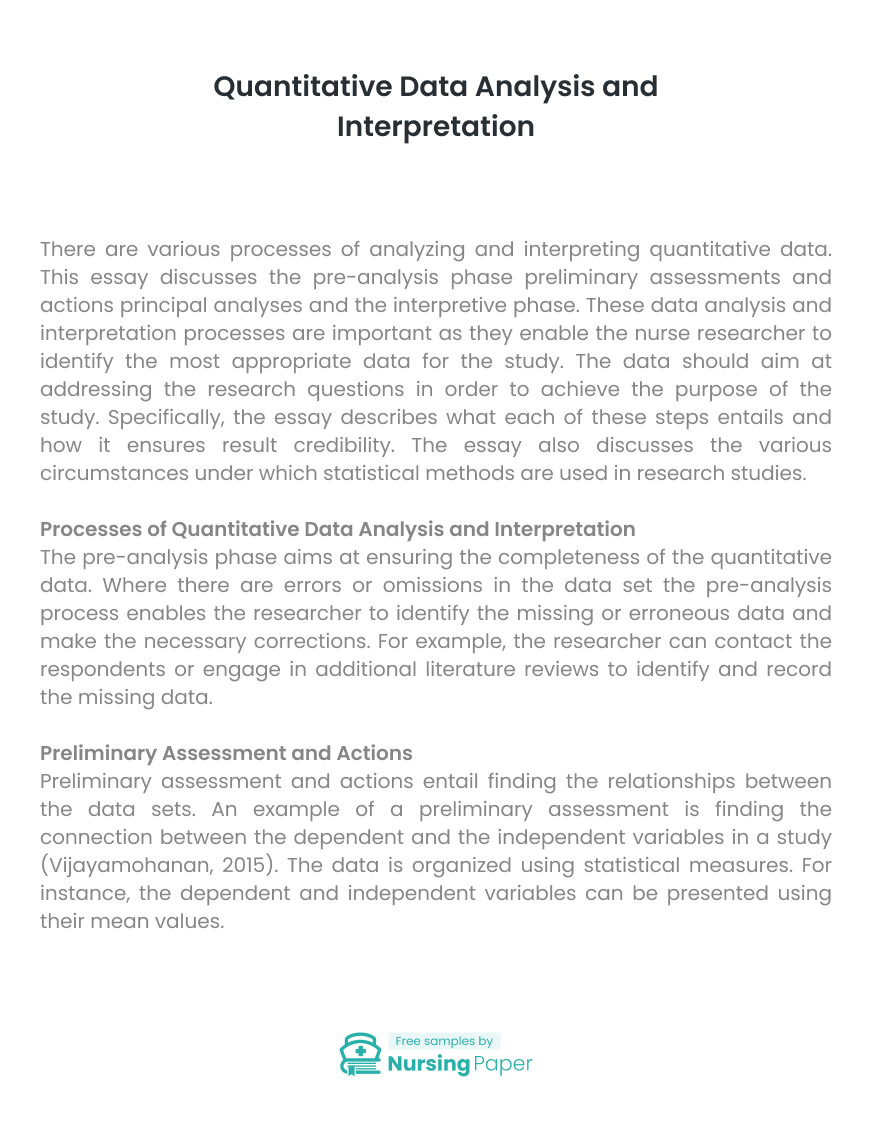
Quantitative Data Analysis and Interpretation
Introduction
There are various processes of analyzing and interpreting quantitative data. This essay discusses the pre-analysis phase preliminary assessments and actions principal analyses and the interpretive phase. These data analysis and interpretation processes are important as they enable the nurse researcher to identify the most appropriate data for the study. The data should aim at addressing the research questions in order to achieve the purpose of the study. Specifically, the essay describes what each of these steps entails and how it ensures result credibility. The essay also discusses the various circumstances under which statistical methods are used in research studies.
Processes of Quantitative Data Analysis and Interpretation
The pre-analysis phase aims at ensuring the completeness of the quantitative data. Where there are errors or omissions in the data set the pre-analysis process enables the researcher to identify the missing or erroneous data and make the necessary corrections. For example, the researcher can contact the respondents or engage in additional literature reviews to identify and record the missing data.


Preliminary Assessment and Actions
Preliminary assessment and actions entail finding the relationships between the data sets. An example of a preliminary assessment is finding the connection between the dependent and the independent variables in a study (Vijayamohanan, 2015). The data is organized using statistical measures. For instance, the dependent and independent variables can be presented using their mean values.
Principal Assessment and Actions
The principal assessment and actions stage examines the variance in the statistical data. Statistical techniques like range and standard deviation are effective in illustrating the variance in the quantitative data set (Varandani, 2016). In a practical sense, researchers could examine the differences between hospice care and home care, illustrate the range, and then use this to determine the standard deviation or the variance values.
Interpretive Phase
The interpretive phase, on the other hand, examines the connection between the data and the research questions. The data must be effective in offering answers to the research questions (Varandani, 2016). In a research study on enhancing the outcomes of the cancer patients, the research data should illustrate the most effective care or treatment strategies.

Statistical Methods
Statistical methods measure the central tendencies and the dispersion of the data set (Vijayamohanan, 2015). For example, the mean can measure the average number of patients who are treated in a health facility on a monthly basis. The range is a dispersion measure that illustrates the differences in the patient results or outcomes. In research studies, the statistical methods show the correlation between the dependent and the independent variables. For example, a nurse researcher could use statistical measures to determine how effective diagnosis improves the recovery rate of patients.
1. Vijayamohanan, P. (2015). Data Analysis and Interpretation. In Induction Training Programme (pp. 1-32). Institute of Management in Government in collaboration with DoPT, Government of India: Institute of Management in Government in collaboration with DoPT, Government of India. Retrieved from https://www.researchgate.net/profile/Vijayamohanan_Pillai_N/publication/282286137_Data_Analysis_and_Interpretation/links/560a6ea708ae4d86bb138dc6/Data-Analysis-and-Interpretation.pdf?origin=publication_detail
2. Varandani, M. (2016). Chapter 5: Data Analysis and Interpretation. Retrieved from http://shodhganga.inflibnet.ac.in/bitstream/10603/129356/6/data%20analysis%20and%20interpretation.pdf



The download will start shortly.

The download will start shortly.
 Subject:
Medicine
Subject:
Medicine  Number of pages: 2
Number of pages: 2  Subject:
Nursing
Subject:
Nursing  Number of pages: 4
Number of pages: 4  Subject:
Health and Social Care
Subject:
Health and Social Care  Number of pages: 3
Number of pages: 3  Subject:
Nursing
Subject:
Nursing  Number of pages: 6
Number of pages: 6  Subject:
Health and Social Care
Subject:
Health and Social Care  Number of pages: 2
Number of pages: 2  Subject:
Nursing
Subject:
Nursing  Number of pages: 3
Number of pages: 3  Subject:
Nursing
Subject:
Nursing  Number of pages: 4
Number of pages: 4  Subject:
Medicine
Subject:
Medicine  Number of pages: 3
Number of pages: 3  Subject:
Health and Social Care
Subject:
Health and Social Care  Number of pages: 4
Number of pages: 4  Subject:
Medicine
Subject:
Medicine  Number of pages: 7
Number of pages: 7  Subject:
Nursing
Subject:
Nursing  Number of pages: 2
Number of pages: 2  Subject:
Health and Social Care
Subject:
Health and Social Care  Number of pages: 2
Number of pages: 2  Subject:
Nursing
Subject:
Nursing  Number of pages: 6
Number of pages: 6  Subject:
Nursing
Subject:
Nursing  Number of pages: 2
Number of pages: 2  Subject:
Medicine
Subject:
Medicine  Number of pages: 3
Number of pages: 3 
